by Matt Corrion
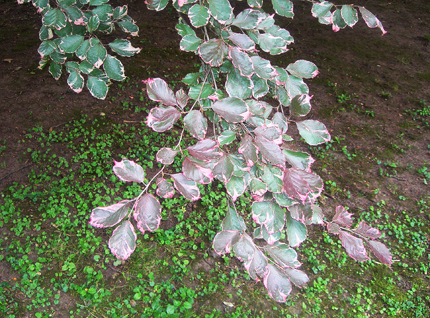
I took this photo a few years ago while traveling through Germany. I believe that this is a Tri Color Beech or Fagus sylvatica ‘Roseo-Marginata’. We were in a park that had several huge, towering trees that were covered in a pink hue! I had never noticed trees like these before.
When we got back home, I did a little research and the consensus seemed to be that these beech trees do not grow so well here in Colorado. However, I just looked it up in the Front Range Tree Recommendation List, and it was given a “B” grade (not too bad). Has anyone out there planted these? What experiences can you share about this tree?
This is the official blog of Outdoor Design Group, Colorado Landscape Architects. For more information about our business and our services, click here.
Related Posts:
by Matt Corrion
Evergreens are important Xeriscape plants for Colorado landscapes. Since lawn areas are often limited in Xeriscaping design, evergreen plants can step right in to provide rich green color all year long.
Evergreen plants also provide great contrast with other plants, particularly with the the foliage and seed heads of ornamental grasses, and as a backdrop for flowering shrubs and perennials. And evergreens can often be utilized to effectively create privacy and screen or block undesirable views in the landscape.
I am limiting this top 10 list to evergreen shrubs. Another very interesting category of plants are the so called “semi-evergreens”, which are deciduous plants that keep all or part of their foliage throughout the winter. I will do a future list of the top semi-evergreen Xeriscape plants. I am also excluding large trees from this list, as they are a category unto themselves and many people are already familiar with evergreen tree choices.
Although this is a Colorado list, most of these plants can be used in many places throughout the world depending on the local climate.
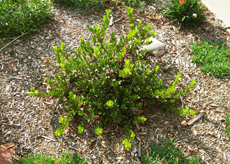
- Panchito Manzanita – Arctostaphylos x coloradoensis ‘Panchito’ Panchito Manzanita is a low growing woody shrub with shiny, oval, dark green leaves that persist throughout the winter. It gets small, pale pink flowers followed by small red berries- but it’s best characteristics are the evergreen foliage and the fact that it requires little care or water. The only time I have had an issue with this plant was when it was placed in an area with very poor soil and poor drainage- even then, the plant looked healthy, it just didn’t get any larger.
- Kinnickinnick – Arctostaphylos uva-ursi Since the Mock Bearberry and Panchito Manzanitas have become some of my favorite plants, I started taking a second look at their cousin the Kinnickinnick. This plant has been around for a long time and thrives in the eastern U.S. Here in Colorado, it needs full to partial shade and requires a little more water. It stays a little smaller than the other Manzanitas, but since there are so few evergreens that thrive in shade it is an invaluable plant.
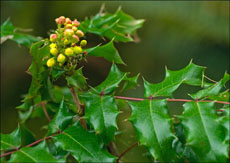
- Oregon Grape Holly – Mahonia aquifolium I consider Oregon Grape Holly to be an evergreen plant, even though that may not be botanically correct. It has large, glossy leaves that persist through winter, turning bronze-red, and gets clusters of small yellow flowers in the spring. It can handle a ton of different conditions, from partial sun, through full shade, and doesn’t seem to mind the toughest clay soil. This plant is a true staple of the Colorado Xeriscape. Oregon Grape Holly gets about 4-6 feet wide and tall, with the “compacta” variety staying about half of that size.
- Yucca – Yucca ssp. Native to the Southwestern United States and Mexico, Yuccas are another plant that is not generally thought of as an evergreen. But they are just about the perfect evergreen plant for a Xeriscape! Yuccas provide really good steady green foliage that can blend in with other plants or be used as a statement with it’s unique form. A tall stalk of white flowers appears in summer to make these plants all the more interesting. All that, from plant that is native to Colorado and requires no maintenance or no supplemental watering! Note: Red Yucca is another great plant that gets red flowers instead of white. It’s scientific name is Hesperaloe parviflora.
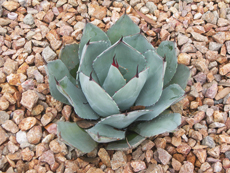
- Agave – Agave parryi Agaves are very similar to Yuccas, and provide many of the same benefits. They tend to grow slower, and are a little smaller, so I recommend using them closer to pathways so their foliage can be enjoyed. Agaves only flower once every 25 years, sending up a very tall flower stalk. After they flower, the parent plant dies, and is replaced bu suckers from the root.
- Dwarf Globe Blue Spruce – Picea pungens ‘Glauca Globosa’ Most people would not consider this a true Xeriscape plant, but I am including it because I have had very good luck with these plants in Xeriscapes. Being a spruce, they do require a little more watering until they are established. However I have seen these plants used in low water use landscaped on the same drip zone as true Xeriscape plants and they have thrived. The blue color and the fact that they stall relatively compact are characteristics that cannot be found with any other plants that I am aware of.
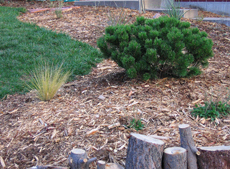
- Mugo Pine – Pinus mugo ssp. Mugo pines can provide very good dark green color, and are perfectly adapted to Colorado’s climate. They are a perfect accent to boulders and flowering perennials. Be sure to give them plenty of room, they are slow growing and are usually pretty small at the time of planting- however most of the varieties will get quite large over time.
- Spreading Junipers – Juniperus horizontalis ssp. Junipers have been given a bad name, as we have written about before, but creeping or spreading junipers require little maintenance and can be very valuable parts of a well designed Xeriscape. These plants work well when mixed with a variety of flowering and deciduous plants and grasses. They can provide good ground coverage and green color to break up large mulch areas and as understory between shrubs. Varieties such as “Youngstown” and “Blue Chip” offer a variety of green to blue-green hues.
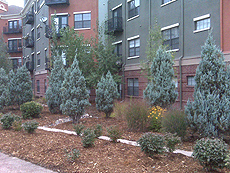
- Upright Junipers – Juniperus scopulorum ssp. These upright shrubs can work well as vertical elements in a Xeriscape (as seen above), or to provide screening of utility areas. Some of the varieties stay very narrow, which can be invaluable in tight spaces where evergreen trees would get far too wide. Be wary of limb breakage in very heavy snows, especially with very narrow varieties such as “Skyrocket”. Junipers are native to Colorado and require very little water, care, or maintenance.
- Compact Tanyosho Pine – Pinus densiflora ‘Globosa’ Compact Tanyosho Pine is a unique large shrub or small tree that has a very nice dark green color and requires minimal maintenance. It is one of the rare evergreen trees that stays very compact, yet requires little water unlike many of the other dwarf conifers. It also has an interesting form, with one or multiple bare trunks at the base with the needles forming a mound at the top.
This is the official blog of Outdoor Design Group, Colorado Landscape Architects. For more information about our business and our services, click here.
Related Posts:
by Matt Corrion
We are conducting a new poll to learn more about the attitudes of people toward different landscape styles. Please take a moment and vote below- Thanks!
This is the official blog of Outdoor Design Group, Colorado Landscape Architects. For more information about our business and our services, click here.
Related Posts:
by Matt Corrion
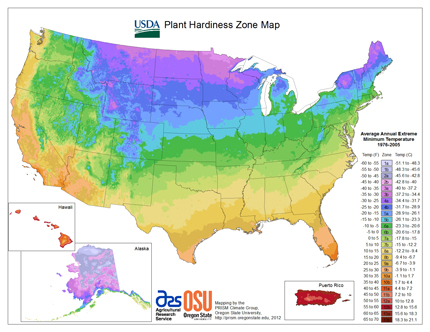
On January 25th, the U.S. Department of Agriculture (USDA) released an updated version of their Plant Hardiness Zone Map. Here are some excerpts from the USDA website, where you can also view and download the new maps:
The 2012 USDA Plant Hardiness Zone Map is the standard by which gardeners and growers can determine which plants are most likely to thrive at a location. The map is based on the average annual minimum winter temperature, divided into 10-degree F zones.
For the first time, the map is available as an interactive GIS-based map, for which a broadband Internet connection is recommended, and as static images for those with slower Internet access. Users may also simply type in a ZIP Code and find the hardiness zone for that area.
No posters of the USDA Plant Hardiness Zone Map have been printed. But state, regional, and national images of the map can be downloaded and printed in a variety of sizes and resolutions.
My thoughts: It is kind of surprising that the maps have not been updated since 1990.
You can enter your zip code, search by state, or simply click on your state on the national map to get a new state map.
Colorado, like most places, got a little warmer. Now Zone 3 only includes areas at high elevations. The foothills are a mix of Zone 4 and 5, and the urban “heat island effect” is taken into consideration with Denver in Zone 6. What changes are you seeing for your area?
This is the official blog of Outdoor Design Group, Colorado Landscape Architects. For more information about our business and our services, click here.
Related Posts:






